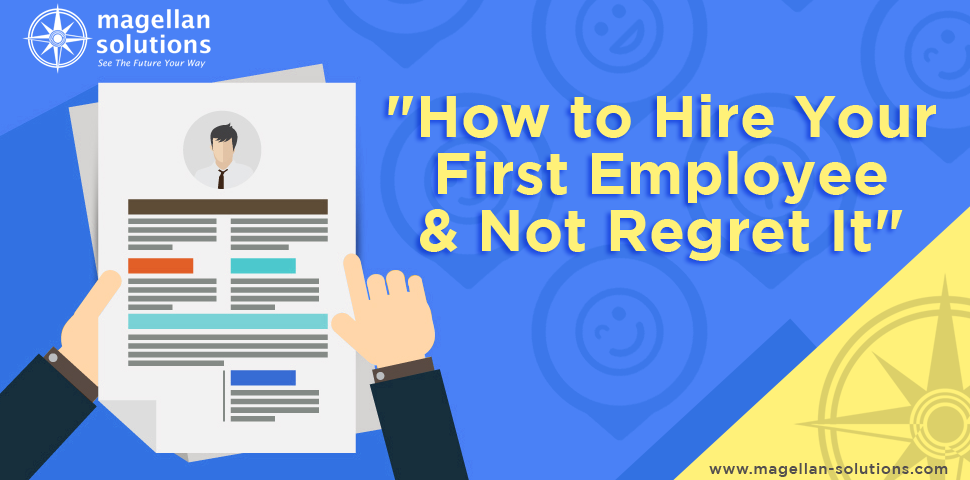Jan 24, 2019 The Role of Your First Hire When you hire your first employee, it needs to be another you; for instance, someone you can sit around with for long hours (probably late at night) bouncing ideas around and writing code. Jul 25, 2016 And if your first employee is actively damaging, your very business could be at risk. But on the other hand, no business grows to its full potential with just a single employee. So today, we’ll take a look at five tips to help you when planning for your first employees. 5 Things to remember when hiring your first employee DEVELOP AN EMPLOYEE HANDBOOK. Whether you plan to hire one employee or many employees, you will want to develop an employee handbook. An employee handbook clearly states company policy, conduct. Jan 23, 2014 So today, we’ll take a look at five tips to help you when planning for your first employees. 5 Things to remember when hiring your first employee DEVELOP AN EMPLOYEE HANDBOOK. Whether you plan to hire one employee or many employees, you will want to develop an employee handbook. An employee handbook clearly states company policy, conduct. Oct 19, 2018 Congratulations, you're about to hire your first employee! Deciding to bring on your first employee is an exciting time. Chances are if you need to hire someone, your business has flourished to the point where you can no longer remain a one-person show, a good problem to have.
- How To Hire Your Very First Employee Portal
- How To Hire Your Very First Employee Email
- How To Hire Your Very First Employee Interview
- How To Hire Your Very First Employee Service
- How To Hire Your Very First Employee Job

1. Fill out all your employee onboarding forms
First, have your employee fill out a W-4 form to tell you how much income tax they want withheld from their paychecks. Next, they’ll need to fill out the I-9 form to prove they’re allowed to work in the U.S. With the I-9 form, you’ll also need to check their passport or other ID. (Don’t worry, all the instructions are on the form, just make sure they bring their IDs on the first day.) Once these forms are complete, you must keep copies of them in your records.
2. Report your new hires to the state

Now, you’ll need to send some info to the state where they’ll be working. The state uses these details to keep track of people who owe certain government debts, like child support. In general, this should be filed within 20 days of their start date, but some states require it sooner, so it’s important to get to it right away.
3. Get workers’ compensation insurance
Almost every state requires employers to have workers’ comp insurance. You can nab this insurance either through a commercial carrier or through your state’s workers’ comp program. Workers’ comp gives your team certain benefits and covers your business in case of illness or injuries that can come up while an employee is working.
4. Hang up those workplace posters
There are certain posters that you need to tack up in your offices depending on the city, county, and state where your business is located. Flip through the Department of Labor’s Poster Advisor tool to find the required posters for your area, and then print them out and get them up.
5. Follow the main labor law requirements
It’s a good idea to get familiar with labor laws, such as minimum wage, wage garnishments, termination issues, and worker classification. Sound intense? Fortunately, there are tons of places where you can bone up on the basics.
A great resource for this info is the Department of Labor’s Employer Guide. We also recommend checking out the U.S. Small Business Administration’s 10 Steps to Starting a Business. The information they provide discusses everything from writing a business plan to applying for licenses and permits.
As your business grows and prospers, it may be time to hire your first employee. From the U.S. Small Business Administration, here are eight steps you should take that will help you start the hiring process and ensure you are compliant with key federal and state regulations.
Step 1 | Obtain an Employer Identification Number (EIN)
Before hiring your first employee, you need to get an employment identification number (EIN). It’s also referred to as an Employer Tax ID or as Form SS-4.
Why you need one: The EIN is necessary for reporting taxes and other documents to the IRS. In addition, the EIN is necessary when reporting information about your employees to state agencies. You can apply online for an Employer Tax ID from the U.S. Internal Revenue Service.
Step 2 | Set up Records for Withholding Taxes
You must keep records of employment taxes for at least four years.
Below are three types of withholding taxes you need for your business:
- Federal Income Tax Withholding
Every employee must provide an employer with a signed withholding exemption certificate (Form W-4) on or before the date of employment. The employer must then submit Form W-4 to the IRS. For specific information, read the IRS’ Employer’s Tax Guide [PDF].
- Federal Wage and Tax Statement
Every year, employers must report to the federal government wages paid and taxes withheld for each employee. This report is filed using Form W-2, wage and tax statement. Employers must complete a W-2 form for each employee who they pay a salary, wage or other compensation. Employers must send Copy A of W-2 forms to the Social Security Administration by the last day of February to report wages and taxes of your employees for the previous calendar year. In addition, employers should send copies of W-2 forms to their employees by Jan. 31 of the year following the reporting period. Visit SSA.gov/employer for more information.
- State Taxes
Depending on the state where your employees are located, you may be required to withhold state income taxes. Visit SmallBusiness.com’s state and local tax page for more information.
Step 3 | Employee Eligibility Verification
Federal law requires employers to verify an employee’s eligibility to work in the United States. Within three days of hire, employers must complete Form I-9, employment eligibility verification, which requires employers to examine documents to confirm the employee’s citizenship or eligibility to work in the U.S. Employers can only request documentation specified on the I-9 form.
How To Hire Your Very First Employee Portal
Employers do not need to submit the I-9 form with the federal government but are required to keep them on file for three years after the date of hire or one year after the date of the employee’s termination, whichever is later.
Employers can use information taken from the Form I-9 to electronically verify the employment eligibility of newly hired employees by registering with E-Verify.
Visit the U.S. Immigration and Customs Enforcement agency’s I-9 website to download the form and find more information.
Step 4 | Register with Your State’s New Hire Reporting Program
All employers are required to report newly hired and re-hired employees to a state directory within 20 days of their hire or rehire date. Visit the New Hires Reporting Requirements page to learn more and find links to your state’s New Hire Reporting System.
Step 5 | Obtain Workers’ Compensation Insurance
How To Hire Your Very First Employee Email
All businesses with employees are required to carry workers’ compensation insurance coverage through a commercial carrier, on a self-insured basis or through their state’s Workers’ Compensation Insurance program.
Step 6 | Post Required Notices
Employers are required to display certain posters in the workplace that inform employees of their rights and employer responsibilities under labor laws. Visit the Workplace Posters page for specific federal and state posters you’ll need for your business.
Step 7 | File Your Taxes
Generally, employers who pay wages subject to income tax withholding, Social Securit, and Medicare taxes must file IRS Form 941, Employer’s Quarterly Federal Tax Return. For more information, visit IRS.gov.
New and existing employers should consult the IRS Employer’s Tax Guide to understand all their federal tax filing requirements.
How To Hire Your Very First Employee Interview
Step 8 | Get Organized and Keep Yourself Informed
Being a good employer doesn’t stop with fulfilling your various tax and reporting obligations. Maintaining a healthy and fair workplace, providing benefits and keeping employees informed about your company’s policies are key to your business’ success. Here are some additional steps you should take after you’ve hired your first employee:
Set up Recordkeeping
In addition to requirements for keeping payroll records of your employees for tax purposes, certain federal employment laws also require you to keep records about your employees. The following sites provide more information about federal reporting requirements:

Complying with standards for employee rights in regards to equal opportunity and fair labor standards is a requirement. Following statutes and regulations for minimum wage, overtime, and child labor will help you avoid error and a lawsuit. See the Department of Labor’s Employment Law Guide for up-to-date information on these statutes and regulations.
Also, visit the Equal Employment Opportunity Commission and Fair Labor Standards Act.
How To Hire Your Very First Employee Service
Related Articles
How To Hire Your Very First Employee Job
American employers hired fewer workers than forecast in August and the jobless rate dropped because…
It is important–and sometimes, required by law–to set up and manage personnel and employee files.…
Small business hiring by companies with fewer than 50 employees added a healthy 102,000 jobs…
